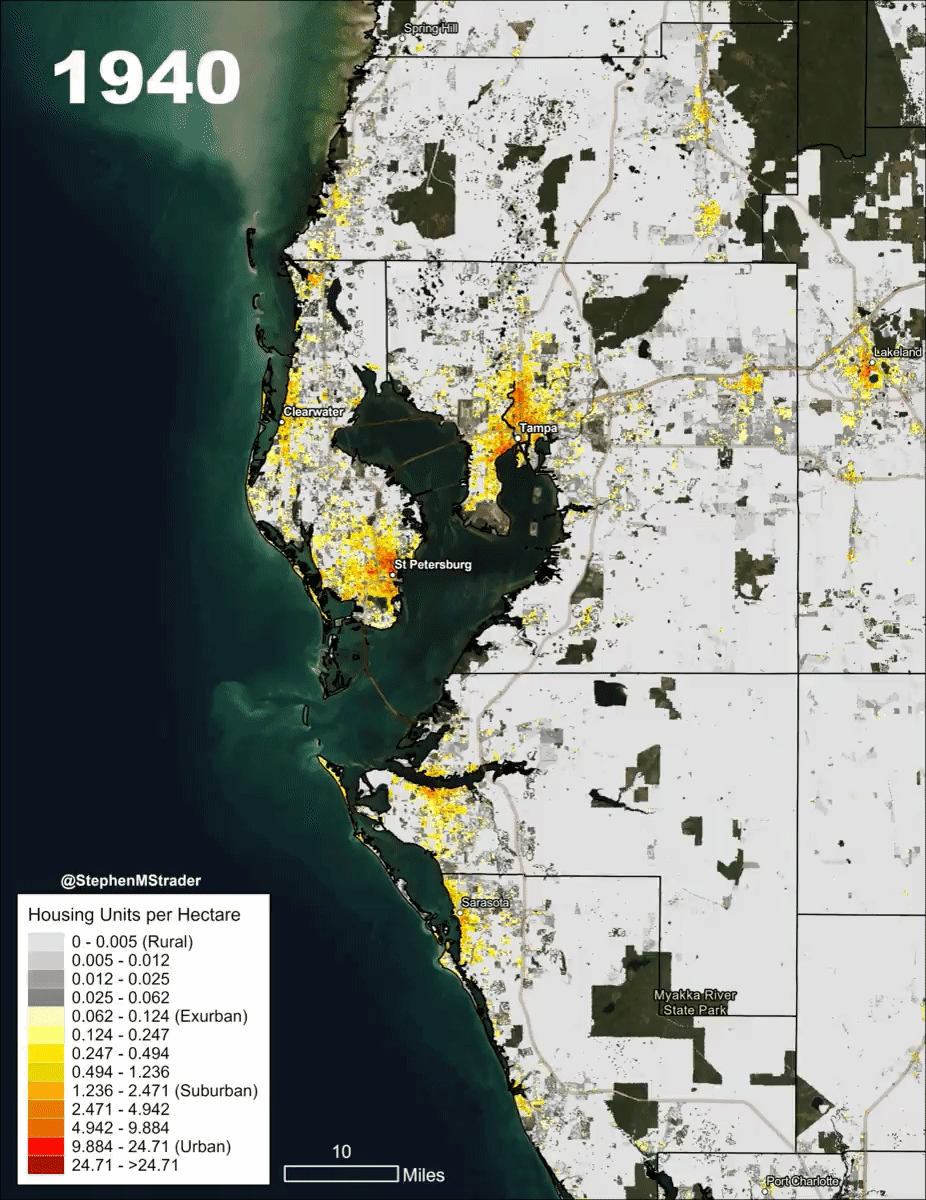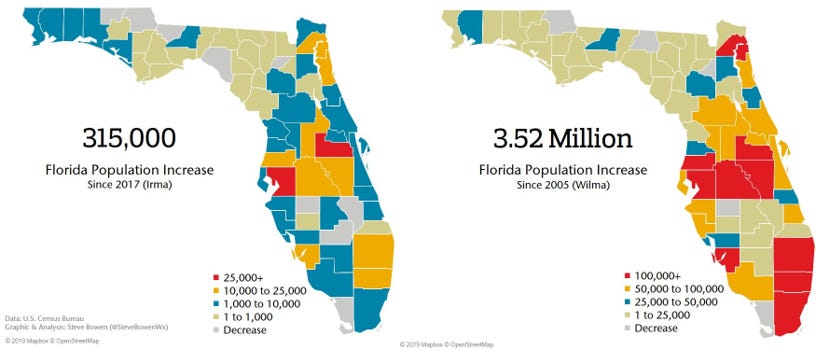SERIES: Making Sense of Trends in Disaster Losses
Part 3: Normalized Hurricane Losses in the United States, 1900 to 2021

This post is part of an ongoing series on understanding disaster losses. You can find Part 1 here, introducing the concept of “normalization,” and Part 2 here newly applying the methodology to European disasters.
As I write this, Hurricane Ian has just made landfall over western Cuba. It is projected to develop into a major hurricane over the Gulf Of Mexico before making landfall on the central west coast of Florida, possibly as a major hurricane. This post reviews our work in recent decades on normalized U.S. hurricane losses, a time series which is essential to placing contemporary storms into context. You won’t hear about this widely-cited research in the major media.
Ian has potential to be have a major impact. Artemis reports, “Reinsurance broker Guy Carpenter has discussed analog historical storms with industry losses ranging from single digit billions of dollars, up to $35 billion.” To go from insurance industry losses to overall direct losses, the general practice is to simply multiply by two, meaning that on these estimates Ian could wind up causing $70 billion in total losses.
As this series has explained, making sense of disasters losses over time is made complicated by the fact that development of coastlines has created far more exposure over time. Even in the past few decades, economic growth and development has dramatically changed loss potentials in many places near the coasts. The Graph below via Steve Bowen illustrates population growth in Florida from 2017 to 2019 (left) and 2005 to 2019 (right).
Looking further back in time changes are even more dramatic. Have a look at the remarkable visualization below showing housing growth in the Tampa region, via Stephen M. Strader (who is a recommended follow on Twitter @StephenMStrader). Strader also provides a remarkable statistic: In 1950 there were 445,397 homes in all of Florida. By 2019 there were 9,077,380, an increase of about 20x. No wonder hurricane losses have increased dramatically. Think about that the next time you hear about the increase in “billion-dollar” disasters.


After seeing people often confusing trends in economic losses with trends in hurricanes, about 25 years ago Chris Landsea and I developed a simple methodology to develop estimates of the losses that hurricanes of the past would cause under current societal conditions. We called this methodology “normalization” as a way to distinguish it from other approaches to loss estimation.
We published our first normalization study in 1998, and then provided updated estimates in 2008 and 2018 (we’ll have to see if there is another one to come in 2028!). Our methods and results have proven of use to those in finance, including especially insurance and reinsurance, so we have continued to update the dataset every year. Today there are more than 60 normalization studies for phenomena around the world, and this will be the focus of a future post in this series.
The methodology is straightforward. We take official historical loss estimates and adjust them for the fact that there are more people, more wealth and more structures exposed to loss. We also explore the possible influence of changes in vulnerability over time (which could increase or decrease loss potentials). You can see our basic methodology applied below in an excerpt from our 2018 paper.
To evaluate the overall accuracy our results we compare the resulting time series of “normalized” losses with an independent climatological record of hurricane frequency and intensity. We find strong confirmation that the independent datasets are highly consistent with each other, giving us good confidence in the overall fidelity of the normalization methods applied in this case. Of course, others have looked at our results and most studies have reenforced our conclusions, though a few have suggested that our estimates are either too low or too high.
According to Guy Carpenter, four historical hurricanes are analogous to Ian in 2022: 1896 (Cat-3), 1921 (Cat-3), 1944 (Cat-3) and Gladys 1958 (Cat-2). Of these, the 1944 storm resulted in the most damage in our dataset, ranking 7th all-time with more than $70 billion in total losses. This compares well to Guy Carpenter’s estimate of an upper-end total loss potential of $80 billion. Of course, losses could be even higher depending on Ian’s eventual strength and location at landfall.
The table below shows the top-25 normalized losses from our dataset, were every storm of 1900 to 2021 to make landfall under 2022 societal conditions. At >$70 billion Ian would be a top-10 storm, but far off the incredible $260+ billion in losses were the 1926 Great Miami hurricane to occur today.
The figure below shows the annual time series of normalized losses in our dataset from 1900 to 2021. Just as with overall and major hurricane landfalls, there is no trend in normalized losses for the continental United States.
For those wanting to see a time series of continental U.S. hurricane landfalls in the context of global tropical tropical cyclone activity, I have published those data here. To date, 2022 remains a below average hurricane season, across all major metrics. Ian reminds us that it only takes one storm to turn a below average season in activity into one that is above average in terms of impact.
Below the jump I have made freely available as PDF downloads the papers of mine cited above, specifically:
Klotzbach, P. J., Bowen, S. G., Pielke, R., & Bell, M. (2018). Continental US hurricane landfall frequency and associated damage: Observations and future risks. Bulletin of the American Meteorological Society, 99(7), 1359-1376.
Pielke, R. A., & Landsea, C. W. (1998). Normalized hurricane damages in the United States: 1925–95. Weather and forecasting, 13(3), 621-631.
Pielke Jr, R. A., Gratz, J., Landsea, C. W., Collins, D., Saunders, M. A., & Musulin, R. (2008). Normalized hurricane damage in the United States: 1900–2005. Natural Hazards Review, 9(1), 29-42.
Weinkle, J., Landsea, C., Collins, D., Musulin, R., Crompton, R. P., Klotzbach, P. J., & Pielke, R. (2018). Normalized hurricane damage in the continental United States 1900–2017. Nature Sustainability, 1(12), 808-813.








